BendDAO, a platform that makes NFTs as collateral for loans to borrowers
Key Takeaways
-
BendDAO is the first peer-to-pool NFT lending protocol in the market and is mainly targeted at blue chip users, who are own the biggest share of the NFT market share. More important, BendDAO has boosted monetary efficiency and is less time-consuming than peer-to-peer lending protocols.
-
BendDAO created a number of innovations, such as liquidation health factors and “first bid” auctions, which were all useful tools but became arbitrage tools since they lacked the proper thoughtful procedure. Professional NFT flippers can use NFTs to “withdraw” more Ether from the reserve pool.
-
Right now, BendDAO supports 8 blue chip collections, they are Cryptopunks, BAYC, Doodles, MAYC, Azuki, Space Doodles, Clone X and Moonbirds. Each collection within BendDAO has a distinct leverage loan ratio; Cryptopunk and BAYC have 40%, while the rest have 30%.
-
BendDAO raised 10% of the total funds for token valuation through IFO (3000ETH ). There are currently 1.5 billion $BEND tokens in circulation, representing 15% of the total supply. Bend’s current market price is 0.004, which is lower than the IFO pricing with a market value of 1.82 million (0.009).
Basic Infomation
-
Team member: Anonymous
-
Fundraising: IFO(Initial Fair-Launch Offering), Rasied 3000ETH
-
Current price 0.004 and the marketcup is 1.83M
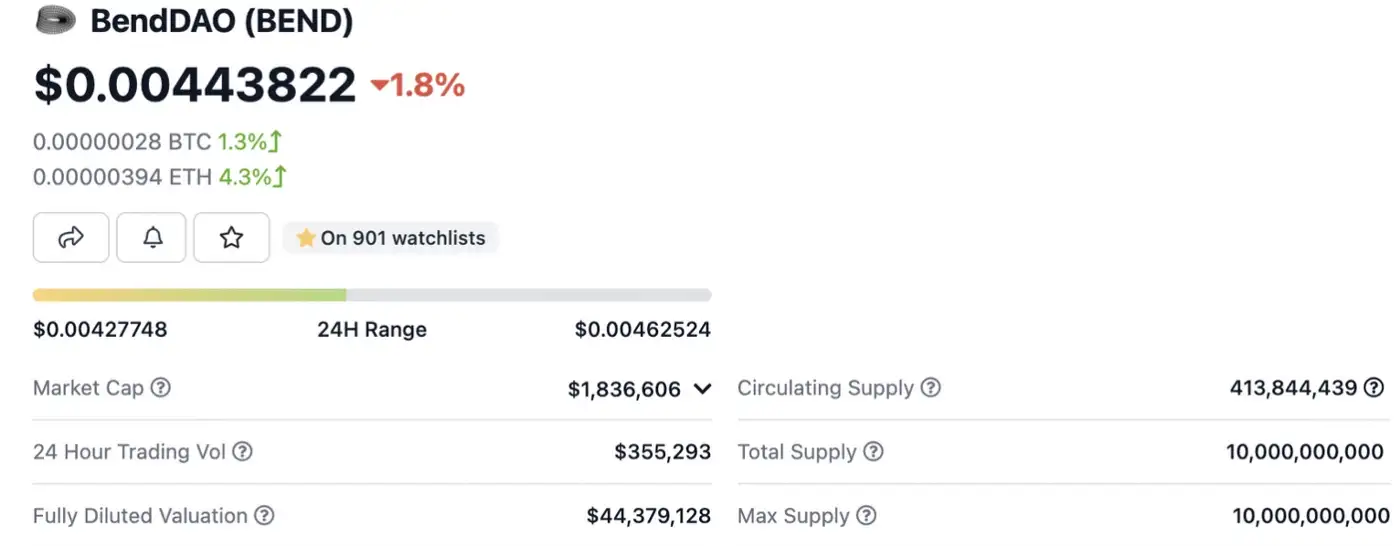
Website:https://www.benddao.xyz
Whitepaper:https://docs.benddao.xyz/portal/
Github:https://github.com/BoundNFT/boundnft-protocol/tree/main/contracts
Mutisig: https://www.certik.com/projects/bend-dao
Twitter:https://twitter.com/BendDAO
Disccord:https://discord.com/invite/BendDAO
Twitter Followers 23.3K
Discord Followers 10.3K
1. How Does BendDAO work?
The Bend protocol uses the NFT floor price from OpenSea and LooksRare as price oracle for NFT collateral and calculates the time-weighted average price (TWAP) of the floor price to eliminate short-term price fluctuations in the NFT market. It is to guarantee the integrity of the floor pricing so that it can be better fit in peer to pool model.
And for holders to participate in BendDAO, NFTs must be deposited into the platform. Those who have NFTs are eligible to apply for loans of up to 40% of the NFT’s value based on its floor price. On the other side, holders who deposit or lend their ETH will receive interest on the borrower’s deposit. Both borrowers and lenders of ETH can obtain the platform governance token $BEND.
Since the project was launched in March 2022, it has been running for about 8 months. At present, in addition to the main lending business, BendDAO has also launched a built-in trading market, which supports the new functions of “buying with down payment” and “pending orders for collateral”, “Peer-to-Peer” lending (Peer-to-Peer) function and satking function for Yuga Labs

2. Core Features
2.1 NFT Liquidation Process
The liquidation mechanism of the BendDAO protocol is a public auction. The Liquidation Threshold is 80%, that is, when the total amount of a certain liability exceeds 80% of the agreement floor price, the health factor of the loan is lower than 1, and the collateral will enter the liquidation process.BendDAO adopts the English auction method, and the starting price must be greater than or equal to the debt principal and interest of the loan and the subsequent auction price must be increased by at least 1% of the total debt amount. If the lender repays at least 50% of the debt amount during the 24-hour auction period, the collateral can be redeemed, but liquidation compensation must also be paid to the first bidder as a reward

2.1.1 Health factor
The health factor is designed for checking the overall risk level for a colleratal NFT
The formula is : Health Factor = (Floor Price * Liquidation Threshold) / Debt with Interests
When the health factor below 1.0, it shows extreme dangerous and will take on an alert on the board
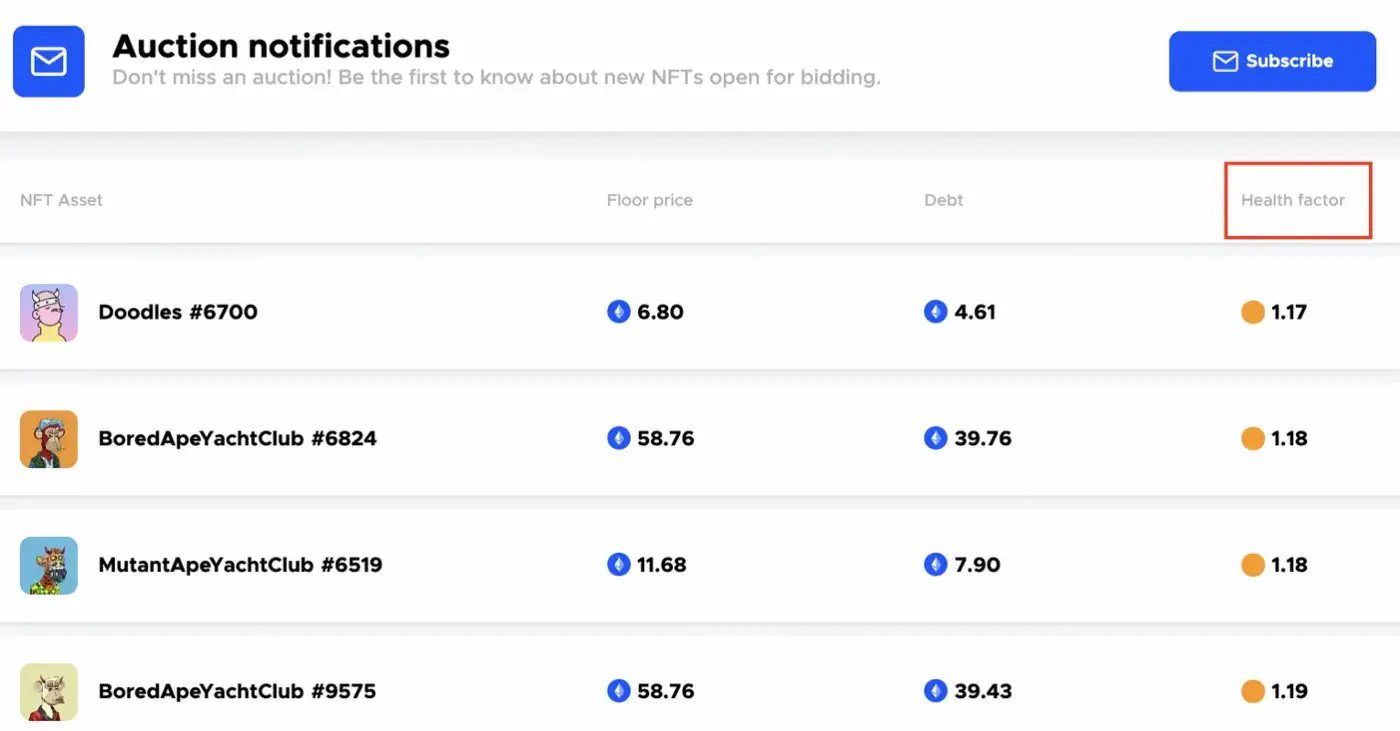
Health Factor Alert(Source: BendDAO)

If the current BAYC floor price is 100 ETH and you lend 40 ETH as collateral, the liquidation mechanism will be triggered when the BAYC floor price falls to 44 ETH because the project’s health index is less than 1.
Health index = (44 * 90%) / (40 + interest) <1
2.2 NFT Trading Marketplace
2.2.1 Collateral Listing
Through the use of Collateral Listing, NFT holders or sellers have the option of taking out an immediate NFT-backed loan and receiving up to 40% of the floor price instantaneously when listing their assets for sale. If you are already a borrower on BendDAO, then you will have the ability to post the collateral whenever you see fit. After the Collateral Listing, the user will transition into the role of both the borrower and the seller on BendDAO.

Work flow of BendDAO (Source: BendDAO Doc)
2.2.2 NFT Down Payment
When purchasing a bluechip NFT, the customer has the option of making a minimum down payment of 60% (depending on the actual price), while simultaneously starting a flash loan from AAVE to cover the remaining balance. The money that was borrowed via the flash loan will be returned through the fast NFT-backed loan that may be obtained through BendDAO.
With the receipt of the down payment, the purchasers will immediately become debtors. Additionally, debtors have the ability to put their mortgaged NFT up for sale on the market.

Workflow of NFT Down Payment (Source: BendDAO Doc)
2.2.3 BendApe Staking(with matching)
Since Yuga Labs is about to open the staking function at the end of 2022, users who hold BAYC, MAYC, BAKC and $APE are open to staking to earn income. Since some staking pools of Yuga Labs need to hold both NFT and $APE tokens (as shown in the figure below), the BendDAO community proposes to develop asset matching based on this staking function, so as to solve the problem that some users only have $APE without NFT or only NFT,
The solution is to combine NFT and $APE in the matching market to maximize the income, and then share the APY.

BendDAO Matching Making for Ape(Surce: BendDAO blog)
3. Related Data
3.1 ETH Borrow and Deposit
3.1.1 Bend Collateral Distribution
we see that the majority NFTs are BAYC and MAYC which accounted for 58.4%

Bend Collateral Distribution(Source: Dune Analytics)
3.1.3 Loans and Repayments
As of November 6, 2022, BendDao’s cumulative loan amount has reached 73,611 ETH, and the current loan amount is 14,696 ETH. The repayment ratio is relatively healthy, currently 80.04%.
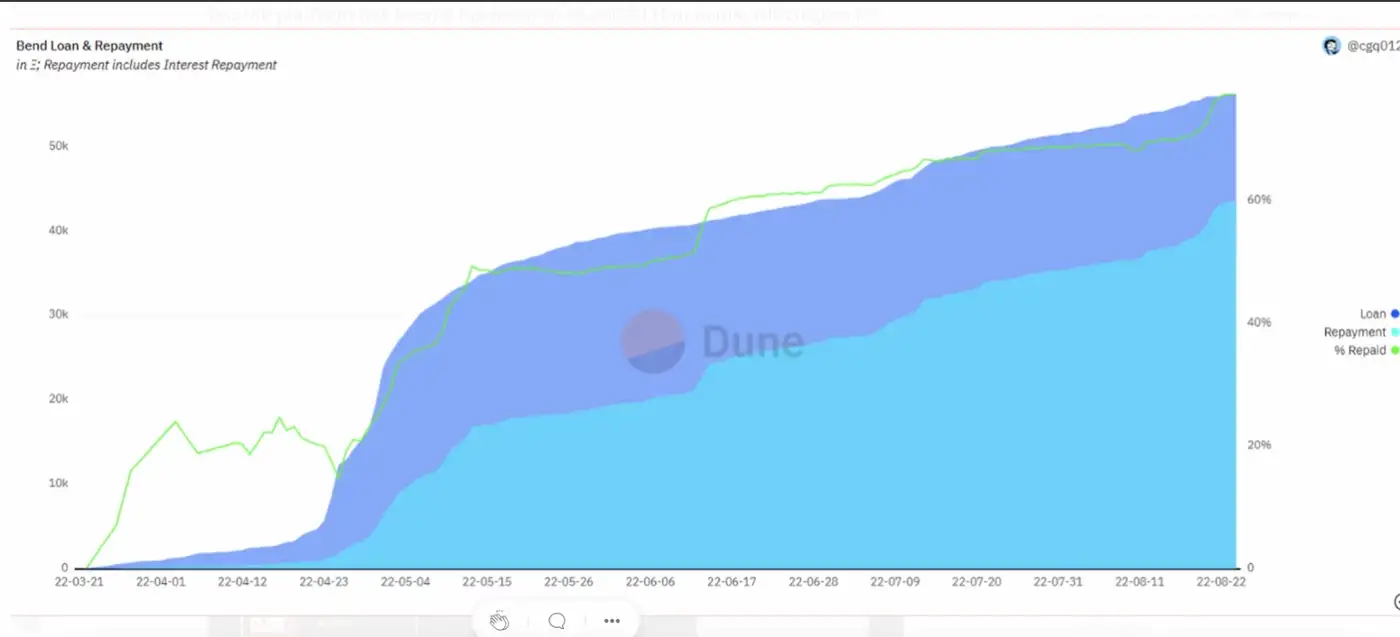
Loadns and Repayments Source: Dune Analytics)
3.1.2 Bend ETH
Through the data, we found that the deposited ETH utilization ratio is relatively healthy

Bend ETH(Source: Dune Analytics)
3.1.4 $Bend Interest Earned
The loan interest is around 2% in average, but the borrow interest is 15% average.

3.2 Bend Airdrop Info
3.2.1 First Airdrop Holders
There are 324,000 of eligable users in which 31,468 are blue chip holders, indicates 9.7% are the top tier in NFT market.

Bend Airdrop(Source: Dune Analytics)
3.2.2 Claimed Airdrop Addresses
There are 3,591 out of 16,464 claimed airdrop, which is 21% of blue chip users are actually know this product.
Bend Claimed Airdrop(Source: Dune Analytics)
3.3 BendDAO (BEND) Tokenomics
3.3.1 Token Distribution

The distribution of BendDAO (BEND) is as follows:
-
21.00% is allocated to the Developer Team
-
10.00% is allocated to Initial Fair-launch Offering
-
21.00% is allocated to Treasury Reserve
-
5.00% is allocated to Airdrop
-
3.00% is allocated to Uniswap LP Incentive
-
40.00% is allocated to Lend/Borrow Incentive
Bend Distribution (Source: BendDAO)
3.3.2 Supply Schedule
The initial token launch date for BendDAO (BEND) is 21 March 2022. The maximum supply of this token is capped at 10,000,000,000. The supply of BendDAO (BEND) is expected to be fully vested by March 2027.
Bend Supply Schedule (Source: BendDAO)
3.3.3 Main usage scenarios of $BEND
The $BEND token is the governance token of BendDAO, with a circulation of 10 billion. Fundraising is open to the public through IFO, accounting for 10% of the total circulation. % (1 billion).
BendDAO follows the VE model, requiring $BEND tokens to be staked in order to obtain veBEND. So the bendDAO revenue is divided into three parts: 30% of the loan interest fee, 50% of the transaction fee (rate 2%), and 50% of the down payment fee (rate 1%), with the remainder going to the Treasury.
4. BendDAO Arbitrage Cases
Loan protocols like BendDAO aim to provide options for NFT holders who want liquidity without forcing them to sell their holdings. Although there is a huge difference in APR between lenders and borrowers from BendDAO, people still lend their BAYC and borrow ETH out in spite of this. WHY?
It all begins with the airdrop news about Otherdeed, the community had boomed hearing this news, some people that are using BendDAO as a airdrop tool,Because simply you can borrow 40Ether by lend out BAYC and then buy 2 MAYC from the secondary market, you will have extra 2 lands airdrop by Yuga labs.
Yes, airdrops brings liquidity; Users are willing to pay more if they are losing money when borrowing ETH.
Another way to make money is the “first bid award”, we know that after the liquidation process starts, the first person to bid will be rewarded by the protocol, a huge loophole has created
This is what Franklin is doing right now, he is the top 10 whale for BAYC holding 61 BYAC, he lends out 14 BAYC as collertals to borrow ETh out, then lowballed the price to as much lower floor price for the BAYC as it can be, so there are a lot of BAYC lining up for liquidation, he offers the first bid to get reward, either he wins the acution or buy the dip from the market, he takes out with 26ETH no matter what.
5. Opportunities and Risks
In fact, before BendDAO, many protocols have already made efforts in the direction of NFT+DeFI. The more familiar ones are NFTFI and NFTX. One is a peer-to-peer NFT lending protocol and the other is an NFT index fund. NFTFI’s lending is peer-to-peer lending, that is, each NFT has a different bid&offer process, which is really inconvenient for users who are in urgent need of cash out. so BendDAO is the best choice for NFT lending at present?
5.1 Oppotunity
5.1.1 “Blue-chip” only Ideology
BendDAO’s NFT lending service is aimed toward NFT whales. It has obvious benefits in terms of product consumer positioning. The NFT market is extremely liquid. This market requires giant whales to guide it; mastering the NFT giant whale will also master the NFT market.
5.1.4 Arbitrage & Attention
The first-mover advantage of BendDAO is that it can help users obtain potential airdrops. Users can complete a series of arbitrage and profit through BendDAO, which will encourage more users to use BendDAO and bring more social media attention
5.1.2 Code Review = Security
BendDAO has currently undergone three code audits. From a security point of view, I don’t think BendDAO will have any security-level code risks, but I cannot guarantee any other systemic risks.
5.1.3 Improve the Efficiency of Money Flow
Peer-to-pool products will outperform peer to peer products in terms of lending speed. The unit price of blue-chip PFP is high, while the fund interest rate is low. Although the market’s original peer-to-peer protocol can provide special pricing due to scarcity, the scarce and expensive blue-chip PFP will face low loan funds, high interest rates. Whereas, BendDAO launched the “peer-to-pool” model, allows these blue-chip PFP holders to immediately lend funds from the fund pool, greatly improving lending speed and accurately serving blue-chip NFT users, and the use of oracle pricing feeds ensures The floor price will not be too low and has a certain degree of resistance to manipulation, and the loan interest rate is controllable to some extent.
5.2 Risks
5.2.1 New Competitors
Besides, BendDAO has many other competitors,such as JPEG’s and Opensky

5.2.3 When “NOT Blue Chip”
The protocol is highly dependent on the quality and quantity of blue-chip PFP collateral assets.
In terms of quality, the collapse of any blue-chip PFP project will directly lead to batch defaults in the protocol. When the floor price of blue-chip PFP drops sharply (or almost returns to zero), lenders can completely abandon NFT assets and choose to default and not repay the loan, and under the current liquidation mechanism, no one will bid for the blue-chip NFT.
5.2.2 $Bend Centralized Problem
According to Dune analytics, the Bend team controls over 45% of the $Bend tokens. This has led to a significant concentration of power that needs to be addressed.
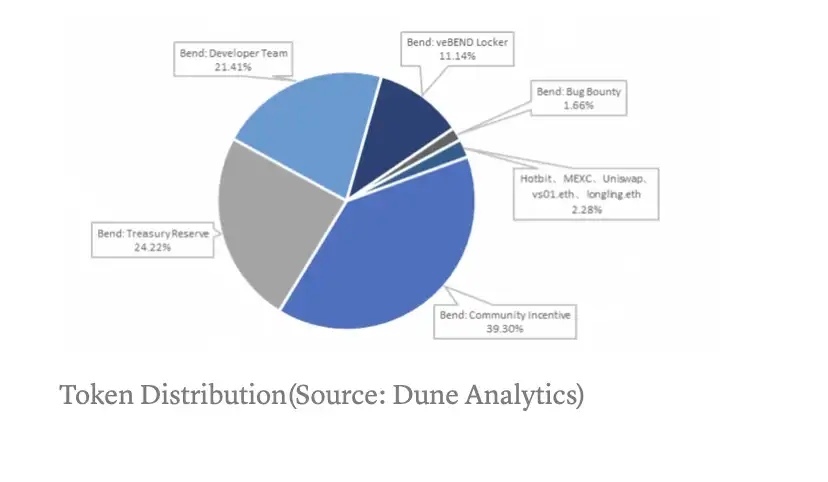
6. Apprendix
6.1 NFT Financialization
I created an overall NFTFi mapping a while ago, which included NFT fragmentation, NFT lending, NFT rental, NFT price feed, NFT aggregator, and NFT trading platform.
6.2 BendDAO Updated Roadmap
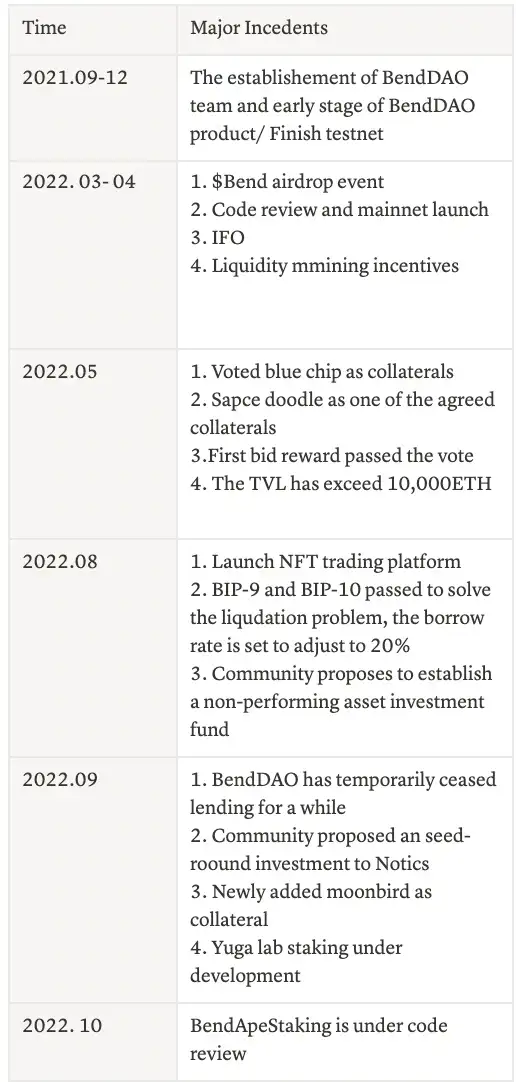
Reference
https://docs.benddao.xyz/portal/nft-liquidity/royalties-on-secondary-sales-creator
https://governance.benddao.xyz/
https://mirror.xyz/snapfingersdao.eth/Botxr9jHvkcSIuo0jX6B6XXxMktRWtn9-m08mObFZZI
https://mirror.xyz/mintventures.eth/j_rG2U7kzykWq8ixOopgNxbI_iLWApGFTHUczE8-Myc
https://dune.com/0xpai/BendDAO-analytics
https://mirror.xyz/oxpepper.eth/aR49ivR6FzFpMPcHdMu0knRlgHKUC-93bsQUS-x9oU4
https://medium.com/rising-capital/breakdown-of-the-benddao-crisis-fd8be29f72f7